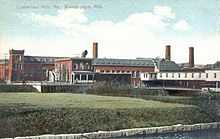S. D. Warren Paper Mill

S.D. Warren Paper Mill is a small mill built on the Presumpscot River in the 1730s in a rural and fairly unpopulated area. In 1854, that small paper mill, in the soon-to-be established town of Westbrook, Maine, was purchased for $28,000 by Samuel Dennis Warren. The mill was named Grant, Warren and Company. In that year, the mill was only running two paper machines and had a production output of about 3,000 pounds of paper per day. Nine years later in 1863, an additional machine was added to the mill, and the production increased to 11,000 pounds per day.
In 1854, paper was made by beating down rags and using the pulp from the rags. In 1867, after the mill changed its name to S.D. Warren Paper Mill Company, Warren decided to add wood fibers with rags fibers for paper, making it the first mill in the United States to do so. The mill became the largest in the world by doing so. By 1880, the mill produced 35,000 pounds of paper per day.
After S.D. Warren’s death in 1888, the mill continued to grow through the 20th century, employing close to 3,000 Westbrook residents.
In 1995, SAPPI Limited, a paper company out of South Africa paid $300 million for the mill, and outsourced most of the work in the mill to South Africa. The mill now only employs about 300 people, but continues to be a presence in the city of Westbrook.
Mill Rail Facilities
Cumberland Mills was served by the Portland and Ogdensburg Railroad (later Maine Central Railroad) and the Portland and Rochester Railroad (later Boston and Maine Railroad). Horse-drawn wagons transferred freight between the mill and the railroads. The wagons rode on 2 ft (610 mm) narrow gauge rails after 1874. Steam locomotives replaced the horses in 1895. The first three locomotives weighed 7 tons each, and carried 200 gallons of water.[1] The locomotives were originally oil fueled; but were converted to burn coal after three employees died in an oil fire during refueling in 1921.[2] Pulpwood was transported into the mill in 20-foot-long cars carrying 2 cords of pulpwood.[3] There were 110 pulpwood cars in 1938 and the mill consumed 180 cords of pulpwood per day.[1] Narrow gauge locomotives transferred 250 tons of coal per day to the mill boilers and transported ash from the boilers to a disposal pile.[4]
The mill also used standard gauge locomotives after spur tracks were extended onto the mill property. The last standard gauge locomotive was sold to the Maine Central Railroad when Portland Terminal Company took over millyard switching work in 1929.[5] The last 2 ft (610 mm) gauge locomotives were sold in 1949 after conveyor systems were constructed to transport materials formerly moved in narrow gauge cars.
Locomotives
| Number | Gauge | Builder | Type | Date | Works number | Notes |
|---|---|---|---|---|---|---|
| 1 | 2 ft (610 mm) | Baldwin Locomotive Works | 0-4-0T | 1895 | 14283 | reboilered 1926 sold 1949 New Jersey amusement park to Boothbay Railway Museum 1971 |
| 2 | 2 ft (610 mm) | Baldwin Locomotive Works | 0-4-0T | 1896 | 14522 | reboilered 1926 sold 1949 New Jersey amusement park to Boothbay Railway Museum 1971 |
| 3 | 2 ft (610 mm) | Baldwin Locomotive Works | 0-4-0T | 1905 | dismantled for parts to keep #1 & #2 operating | |
| 4 | standard | 0-4-0 | ex-Boston and Maine Railroad acquired 1896 retired 1910 | |||
| 5 | standard | 0-4-0 | ex-Boston and Maine Railroad #465 | |||
| 6 | standard | |||||
| 7 | standard | 0-4-0 | ex-Pennsylvania Railroad | |||
| 8 | 2 ft (610 mm) | Davenport Locomotive Works | 0-4-0T | 1914 | ||
| 9 | standard | American Locomotive Company | 0-6-0 | 1924 | sold to Maine Central Railroad #189 in 1929 |
See also
External links
- The S.D. Warren Paper Mill Photographic Collection NO LONGER VALID
- Scott Paper to buy back $300 million in stock and reduce debt by $1.3 billion
- A Brief History of Papermaking in Maine (in Internet Archive)
References
- Andrews, Dick (1987). "The S.D. Warren Paper Company Tram". Narrow Gauge and Short Line Gazette.
- Mason, Beverly L. (1974). "The Mill's Railroads -- Broad and Narrow". Warren's Standard.
Coordinates: 43°41′02″N 70°21′00″W / 43.684°N 70.350°W
| ||||||||||||||||||||||||||||||||||